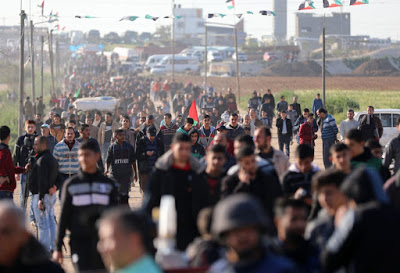Gaza rehearses for 1 million at the fence next week, as Israel kills two more men
 |
| Ahmad Kabariti – March 23, 2019 |
At the end of nearly 1,000 yards of newly-grown spring grassy turf, a renewed barbed-wire border fence rises three meters up, in anticipation of a million person march next week between Gaza protesters and their well-known antagonist snipers.
A week before the first anniversary of the great March of Return, organizers have pledged larger than usual demonstrations. However, their preparations appeared powerless in yesterday’s renewed protests at Malaka, eastern Gaza City, when hails of Israeli live ammunition and gas canisters killed two Palestinian men and wounded 26 others taking part in weekly demonstrations along the fortified Israel-Gaza border.

Barbed wire has been added to the Gaza fence in anticipation of the one year anniversary of the Great March of Return, March 22, 2019. (Photo: Mohammed Asad)
Jihad Harara, 24, was shot in the head east of Gaza City, while Nidal Shatat, 29, was hit in the chest near the Al-Bureij refugee camp in central Gaza. They are the latest of 257 people killed since Palestinians launched the weekly border protests on March 30 last year, demanding the right to return to land from which their ancestors were forced to flee during Israel’s founding in 1948.
Shaza Abu Serriah, 16, and Amany al-Qayed, 20, who just join the rally said they seek to affix a Palestine flag on the fence.

Shaza Abu Serriah (right) and Amany al-Qayed (Photo: Ahmad Al-Kabariti)
The Israeli army did not comment on the deaths but said “approximately 9,500 rioters and demonstrators” gathered in various locations yesterday, “hurling explosive devices, hard objects and rocks” at troops.
“Scared of what?” Amany, a sophomore of social studies, wondered. “We come today to warm up our feelings ahead of the next week. Both women said they were encouraged by their parents to approach the fence. “Once a girl does so, more men will take heart to take down that–not supposed to be–fence,” Shaza told Mondoweiss.
As they spoke, paramedics were seen rushing to carry away those injured a few yards away from the fence, and an angry young amputee protester chanted loudly: “Come on to the Heavens! Come on to your grandfathers’ lands.”

Injured person getting carried away from Gaza fence, March 22, 2019. (Photo: Mohammed Asad)
It has become a normal scene to see amputees walking with a crutch or traveling by wheelchair along Gaza streets, beaches or during the ongoing demonstrations.
For more than months, Israeli snipers have targeted one part of the body more than any other – the legs.
Of the 15,000 protesters treated at hospitals and field clinics in Gaza so far, at least 6,000, or roughly 60 percent, have been struck in the lower limbs, according to Gaza’s Health Ministry last December.

Injured youth is treated at a demonstration at the Gaza fence, March 22, 2019. (Photo: Mohammed Asad)
Also on Friday, the United Nations Human Rights Council condemned Israel’s “apparent intentional use of unlawful lethal and other excessive force” against civilian protesters in Gaza, and called for perpetrators of violations to face justice.
In a surprise visit, Ismail Haniya, chief of the Islamist group Hamas which runs the enclave, urged Palestinians to attend mass rallies on Saturday to mark one year since protests began.
“We will not retreat and whoever thinks that we may retreat a single step backward before achieving our goals is wrong,” Haniyeh said.
The Israeli press is echoing the sense of urgency in Gaza. Alex Fishman of the Israeli paper Yediot Ahronot pressed Israelis to acknowledge Palestinian conditions.
The West Bank is at a boiling point, the Palestinian economy is weak and the motivation for terror attacks high, and now Hamas is planning its biggest demonstration ever to mark the anniversary of the ‘March of Return’; Israel fears events may spin out of control with dozens of casualties and a possible military confrontation.
The only way to stave off this frightening scenario is to implement the partial understandings reached between Egypt, Israel and Hamas. Most of the subject matter was found to be acceptable by both sides. Israel agreed to allow Hamas to expand the Gaza fishing zone to 12 nautical miles from the Gaza coast and allow the UN to fund the employment of some 90,000 Gazans currently without work. Israel also agreed to provide Gaza with additional electricity capacity.
On the ground in Gaza, Musa Abu al-Hatal, a 31-year-old unemployed math graduate, was watching the Friday crowds and marvelling at the “stance of maze,” as he characterized the life of Gaza.
“Being in Gaza means that your mind brainstorms itself constantly over the political situation. They (Israelis) threaten, and we (Palestinians) respond with bluster. It seems a non-ending boxing round and no one from outside wants to be a referee.”

Shooting a sling shot at the Gaza fence, March 22, 2019. (Photo: Mohammed Asad)
Musa said, “I guess next week, thousands of stretchers will be full of injuries and dead, and the same number of crutches will be used by new victims.”

Injured youth is treated at a demonstration at the Gaza fence, March 22, 2019. (Photo: Mohammed Asad)

Demonstration at the Gaza fence, March 22, 2019. (Photo: Mohammed Asad)


